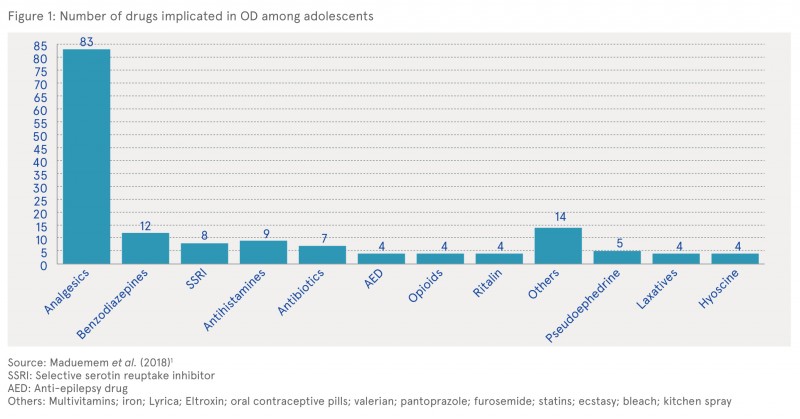Millar, Sean (2018) Hospital presentations and preceding factors of drug overdose among adolescents. Drugnet Ireland, Issue 67, Autumn 2018, 16 p..
| Preview | Title | Contact |
|---|---|---|
|
PDF (Drugnet 67)
730kB |
Suicide is one of the major causes of death in many populations, particularly adolescents, and poisoning or drug overdose (OD) is the leading method of attempted suicide. Public health interventions aim to reduce the morbidity and mortality of self-poisoning by limiting the availability of potentially toxic medications to at-risk populations. An understanding of the preceding factors and potential triggers of self-poisoning and drug overdose may aid in the development of specific intervention strategies.
Recent Irish research aimed to highlight the pattern of presentations and preceding factors of OD in an adolescent population.1 In this study, published in the Irish Medical Journal, the authors retrospectively evaluated the data of 85 adolescents (81.2% female) presenting to a large regional hospital in Ireland with OD over a three-year period. Data were retrieved from the Hospital Inpatient Enquiry (HIPE) system, and included information on patients’ demographics, preceding factors, and drugs used in OD.
Results
The median age at presentation was 15.83 years. The median time from event to hospital presentation was 2.6 hours, with the mean length of hospital stay being 2.24 days. Thirty-eight (44.7%) adolescents had a history of deliberate non-drug-related self-harm, while 14.1% (n=12) were previously seen for deliberate self-poisoning/OD. Among factors associated with OD, the following were noted:
Depression was the most common mental health problem associated with OD.
Other preceding factors included unstable family dynamics, family history of mental illness, social problems, and romantic break-ups.
Certain factors had gender predilection: substance abuse and conduct disorder were more common among males.
The drugs implicated in adolescent OD presentations are shown in Figure 1. The most common agents of overdose were analgesics (n=83), with acetaminophen being the most commonly used analgesic. Other drugs used in OD cases included antidepressants, antipsychotics, antibiotics, and antihistamines. Forty-six (54.1%) cases presented with polypharmacy overdose. Three patients (3.5%) inhaled a kitchen aerosol spray, while concomitant alcohol (vodka) and drug overdose was documented in 17.6% (15/85) of cases.
Conclusions
The authors suggest that the number of OD patients in this study probably represent only a small proportion of OD cases among adolescents and that it is likely that substantial numbers of self-poisoning occur in the community. Gender differences should be considered in the assessment, prevention, and management of future self-harm or suicides by community policymakers and clinicians.
1 Maduemem K, Adedokun C and Umana E (2018) Presentations and preceding factors of drug overdose amongst adolescents admitted to a large regional hospital. Ir Med J, 111(4): 731. https://www.drugsandalcohol.ie/28870/

F Concepts in psychology > Behaviour > Self-destructive behaviour / self-harm > Suicidal behaviour / suicide
G Health and disease > Substance use disorder (addiction) > Drug use disorder > Drug intoxication > Poisoning (overdose)
J Health care, prevention, harm reduction and treatment > Risk and protective factors > Risk factors
J Health care, prevention, harm reduction and treatment > Health care programme, service or facility > Hospital
T Demographic characteristics > Adolescent / youth (teenager / young person)
VA Geographic area > Europe > Ireland
Repository Staff Only: item control page